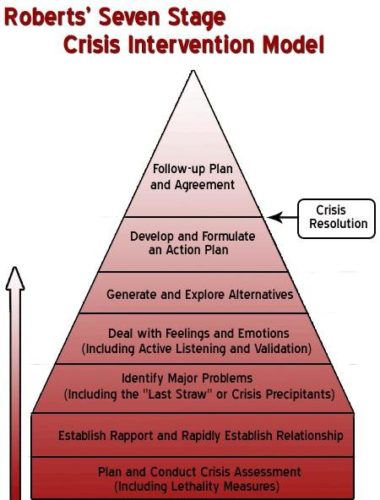“A crisis has been defined as an acute disruption of psychological homeostasis in which one’s usual coping mechanisms fail and there exists evidence of distress and functional impairment.” ~ Albert R. Roberts, PhD
Crisis-inducing events and acute crisis episodes are prevalent in today’s climate especially now with the Covid-19 Pandemic. Often the main cause of a crisis is an intensely stressful, traumatic, or hazardous event which an individual might not be able resolve by using their usual coping mechanisms. Without crisis intervention, many individuals with mental illness end up engaging in harmful behaviors, homeless, or in jail. Enabling the client to utilize effective coping skills to effectively manage the crisis to prevent these types of situations is the goal of crisis intervention.

The “Roberts’ Seven-Sage Crisis Intervention Model” is one way a crisis intervention worker can facilitate the rapid assessment of the individual’s problem. This comprehensive model allows the crisis worker to properly respond to an individual in crisis by meeting the person where they’re at, assess level of risk, mobilize client resources, and move strategically to stabilize the crisis and improve functioning.
The “Roberts’ Seven-Stage Crisis Intervention Model” helps crisis workers rapidly assess individuals and make decisions. Each of these stages are essential in the process of crisis intervention.
- Plan and conduct a thorough biopsychosocial and lethality/imminent danger assessment. This should cover the client’s environmental supports and stressors, medical needs and medication, current use of drugs and alcohol, and internal and external coping methods. The assessment includes asking about self-harm behaviors including suicidal thoughts or ideations.
- Make psychological contact and rapidly establish the collaborative relationship. The crisis worker must offer genuineness, trust, respect, and acceptance in order to rapidly establish rapport with the client.
- Identify the major problems, including crisis precipitants. Focusing on the person’s current problems and seeking to understand how the event escalated into a crisis will lead the crisis worker to learn how the client copes.
- Encourage an exploration of feelings and emotions. Using active listening and reframing, allow the person to express their feelings, vent, heal, and explain their story.
- Generate and explore alternatives and new coping strategies. This often difficult but important stage to accomplish in crisis intervention allows the crisis worker to provide options the person could choose from such as using old or new coping skills, take medications, temporarily relocation, or possibly a brief hospitalization.
- Restore functioning through implementation of an action plan. At this stage, the crisis turns into resolution which is critical in restoring the client’s psychological balance and equilibrium. The cognitive dimension of this stage is also crucial because working through the meaning of an event is important in being able to cope with it in similar situations in the future.
- Plan follow-up and booster sessions. The post-crisis evaluation can include: physical condition of the client, cognitive mastery of the precipitating even, an assessment of overall functioning including, social, spiritual, employment, and academic, satisfaction and progress with ongoing treatment, any current stressors and how those are being handled, and the need for possible referrals, including housing.
If crisis intervention is done properly, it can facilitate a resolution of acute stress disorders and crisis episodes and prevent harmful behaviors, homelessness, or jail time. This model gives the crisis worker the opportunity to successfully help an individual bring forth their inner strengths and resiliency.
We thank our 2020 Undergrad Intern Elena Lamb for her contribution towards this blog.
